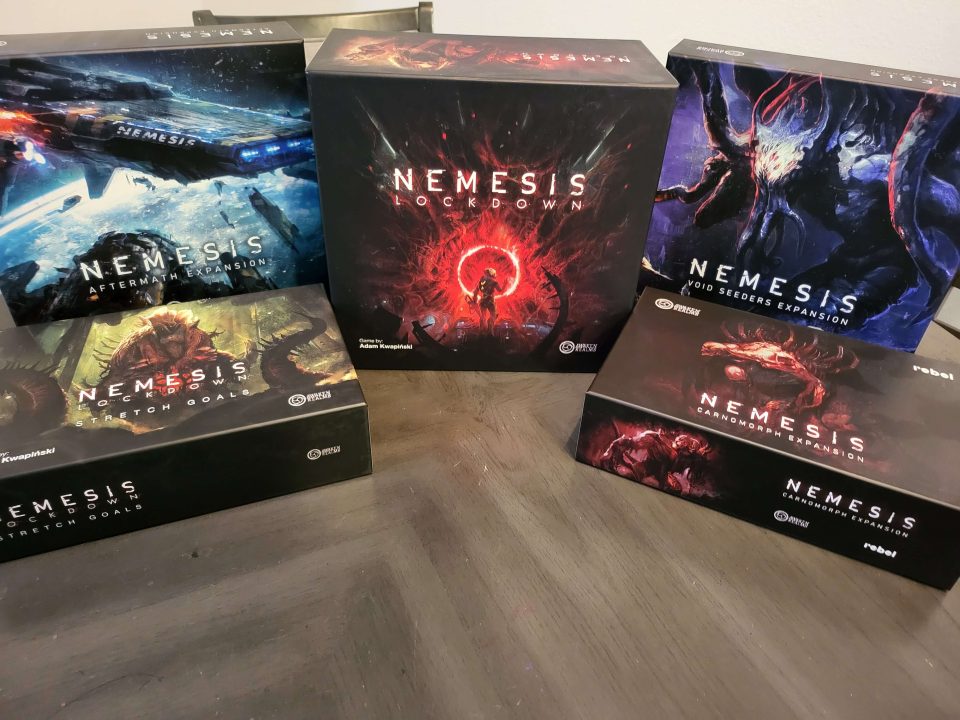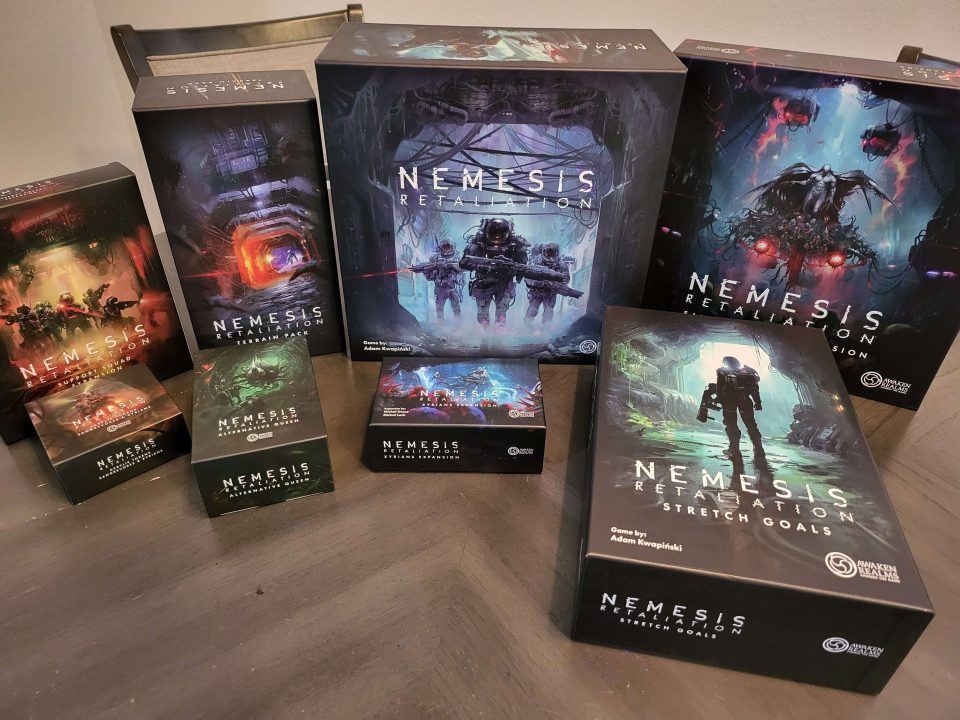Before Nemesis, Horror Was Scary. After Nemesis, It Was Survival.
When Nemesis first launched in 2018, it didn’t just join the horror genre – it set a new standard for tabletop games.
Board games had flirted with fear before (Betrayal at House on the Hill, Arkham Horror, Dead of Winter), but Nemesis did something rare: it made dread mechanical. Every turn carried a consequence. Every noise token felt like a heartbeat. You weren’t watching a horror movie – you were inside one. And if you step too loudly, they’ll find you.
What Awaken Realms built across three games isn’t just a series. It’s a chronicle of fear, control, and consequence – a full-fledged sci-fi saga told through dice rolls, personal objectives, and the sound of your friend swearing they “didn’t mean” to open that door.
Publisher: Awaken Realms
Designer: Adam Kwapiński
Series: Nemesis (2018) • Nemesis: Lockdown (2022) • Nemesis: Retaliation (TBD)
Genre: Sci-Fi Horror • Semi-Cooperative • Story-Driven
Nemesis (2018) – The Birth of Paranoia
The first Nemesis was chaos in a box. A derelict ship, dead crew, and monsters lurking in the vents.
It introduced the signature formula: asymmetric roles, secret objectives, and the constant awareness that the biggest threat at the table might be sitting right next to you.

The system rewarded selfish decisions just enough to make “helping” suspicious. It was Alien on cardboard, complete with backstabbing, flamethrowers, and that one player who swears they’re heading to fix the engines (hint, they’re not).
Play it if: You want that feeling of slow-burn dread where every decision might doom the crew.
Skip it if: You prefer cooperation over chaos.
Read the review here – https://www.theouterhaven.net/?p=313198&preview=true
Nemesis Lockdown (2022) – When Fear Became Strategy
Nemesis: Lockdown took everything unpredictable about the original and caged it inside a Martian research facility.
Gone was the open ship – replaced by red dust, sealed bulkheads, and a flickering power grid that could plunge whole sectors into darkness.

The new mechanics—power management, elevators, and a multi-level map—transformed horror into a tactical puzzle.
It was the first time a board game made you feel brilliant, terrified, and flustered all at once.
Nemesis was a panic attack, and Lockdown is the slow suffocation afterward. (Literally, it introduces an oxygen mechanic)
Play it if: You like intricate systems and strategic tension.
Skip it if: You crave speed or hate flipping back to the rulebook mid-scream.
Read the review here – https://www.theouterhaven.net/?p=313336&preview=true
Nemesis Retaliation (Upcoming 2025) – Turning Fear into Fury
Seven years later, Retaliation promises to flip the script.
This time, you’re not victims anymore – you’re the Marines kicking in the hatch. The hunted have become the hunters… or so they think.

For the first time, humanity is fighting back – and in true Nemesis fashion, it probably won’t go as planned.
Play it if: You’ve survived the others and want closure with a fight.
Skip it if: You prefer pure horror over action horror.
Read the review here – https://www.theouterhaven.net/?p=313379&preview=true
The Evolution of Fear
Each entry in the trilogy represents a different phase of humanity’s relationship with terror:
Nemesis – Fear – Survival – Humanity runs
Lockdown – Control – Science – Humanity meddles
Retaliation – Consequence – Vengeance – Humanity learns nothing
Across three games, Awaken Realms didn’t just iterate – they told a story.
It’s not subtle. It’s brilliant.
The Legacy of the Trilogy
The Nemesis trilogy revolutionized the way people discuss horror in board gaming. It proved that dread could be cinematic, betrayal could be system-driven, and survival could feel personal. It blurred the line between film and tabletop more than any other modern series – complete with official comics that expand the lore between games.
Few publishers attempt continuity at this scale. Fewer still succeed. Every miniature, rule tweak, and scenario feels like part of a living, evolving universe – one that started as confused terror in space and grew into a cautionary tale about humanity’s greatest flaw.
The Nemesis trilogy didn’t invent tabletop horror. But it did perfect it. From the derelict ship to the Martian base to the Intruder-infested facility, Awaken Realms crafted a playable nightmare that other designers are still chasing.
If you own all three, you don’t just have board games – you have a saga. It’s worth taking the time to run through the entirety of the story.
Together, they are the definitive sci-fi horror experience in modern board gaming.
Start with fear. End with fire.
Summary
The bar has been set for tabletop horror.
Pros
- Every game feels like a sci-fi film unfolding on your table
- Each entry refines the last — Nemesis builds fear, Lockdown adds strategy, Retaliation (soon) promises payoff.
- No series nails horror immersion like this. From artwork to components, it’s loaded with personality and paranoia.
- Multiple characters, objectives, and outcomes make every playthrough unique.
- The comics and lore create a cohesive universe rarely seen in board gaming.
Cons
- Every entry has a lenghty setup/teardown, requires a lot of attention, and a few hours of your sanity.
- Lockdown especially pushes the rules-heavy limit. New players might drown without a veteran guide.
- The semi-co-op design means betrayal isn’t a twist – it’s the point. Not every group enjoys that level of mistrust.
- These games eat tables, prepare some space.
- Premium components and expansions make it one of the priciest horror sagas out there (or board game in general).


